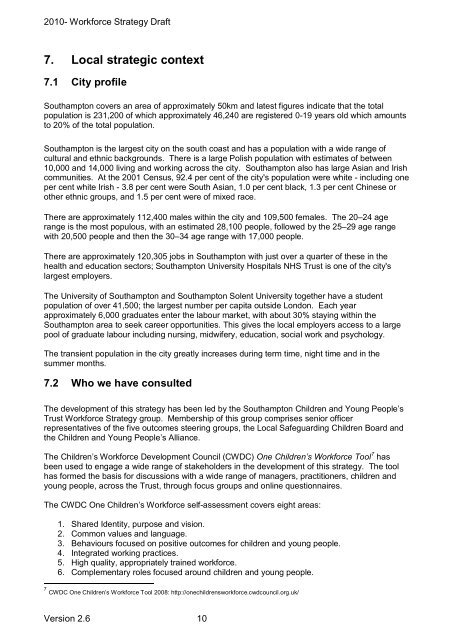Proposed structure for the Children and Young People's Workforce ...
Proposed structure for the Children and Young People's Workforce ...
Proposed structure for the Children and Young People's Workforce ...
- No tags were found...
You also want an ePaper? Increase the reach of your titles
YUMPU automatically turns print PDFs into web optimized ePapers that Google loves.
2010- Work<strong>for</strong>ce Strategy Draft7. Local strategic context7.1 City profileSouthampton covers an area of approximately 50km <strong>and</strong> latest figures indicate that <strong>the</strong> totalpopulation is 231,200 of which approximately 46,240 are registered 0-19 years old which amountsto 20% of <strong>the</strong> total population.Southampton is <strong>the</strong> largest city on <strong>the</strong> south coast <strong>and</strong> has a population with a wide range ofcultural <strong>and</strong> ethnic backgrounds. There is a large Polish population with estimates of between10,000 <strong>and</strong> 14,000 living <strong>and</strong> working across <strong>the</strong> city. Southampton also has large Asian <strong>and</strong> Irishcommunities. At <strong>the</strong> 2001 Census, 92.4 per cent of <strong>the</strong> city's population were white - including oneper cent white Irish - 3.8 per cent were South Asian, 1.0 per cent black, 1.3 per cent Chinese oro<strong>the</strong>r ethnic groups, <strong>and</strong> 1.5 per cent were of mixed race.There are approximately 112,400 males within <strong>the</strong> city <strong>and</strong> 109,500 females. The 20–24 agerange is <strong>the</strong> most populous, with an estimated 28,100 people, followed by <strong>the</strong> 25–29 age rangewith 20,500 people <strong>and</strong> <strong>the</strong>n <strong>the</strong> 30–34 age range with 17,000 people.There are approximately 120,305 jobs in Southampton with just over a quarter of <strong>the</strong>se in <strong>the</strong>health <strong>and</strong> education sectors; Southampton University Hospitals NHS Trust is one of <strong>the</strong> city'slargest employers.The University of Southampton <strong>and</strong> Southampton Solent University toge<strong>the</strong>r have a studentpopulation of over 41,500; <strong>the</strong> largest number per capita outside London. Each yearapproximately 6,000 graduates enter <strong>the</strong> labour market, with about 30% staying within <strong>the</strong>Southampton area to seek career opportunities. This gives <strong>the</strong> local employers access to a largepool of graduate labour including nursing, midwifery, education, social work <strong>and</strong> psychology.The transient population in <strong>the</strong> city greatly increases during term time, night time <strong>and</strong> in <strong>the</strong>summer months.7.2 Who we have consultedThe development of this strategy has been led by <strong>the</strong> Southampton <strong>Children</strong> <strong>and</strong> <strong>Young</strong> People’sTrust Work<strong>for</strong>ce Strategy group. Membership of this group comprises senior officerrepresentatives of <strong>the</strong> five outcomes steering groups, <strong>the</strong> Local Safeguarding <strong>Children</strong> Board <strong>and</strong><strong>the</strong> <strong>Children</strong> <strong>and</strong> <strong>Young</strong> People’s Alliance.The <strong>Children</strong>’s Work<strong>for</strong>ce Development Council (CWDC) One <strong>Children</strong>’s Work<strong>for</strong>ce Tool 7 hasbeen used to engage a wide range of stakeholders in <strong>the</strong> development of this strategy. The toolhas <strong>for</strong>med <strong>the</strong> basis <strong>for</strong> discussions with a wide range of managers, practitioners, children <strong>and</strong>young people, across <strong>the</strong> Trust, through focus groups <strong>and</strong> online questionnaires.The CWDC One <strong>Children</strong>’s Work<strong>for</strong>ce self-assessment covers eight areas:1. Shared Identity, purpose <strong>and</strong> vision.2. Common values <strong>and</strong> language.3. Behaviours focused on positive outcomes <strong>for</strong> children <strong>and</strong> young people.4. Integrated working practices.5. High quality, appropriately trained work<strong>for</strong>ce.6. Complementary roles focused around children <strong>and</strong> young people.7 CWDC One <strong>Children</strong>’s Work<strong>for</strong>ce Tool 2008: http://onechildrenswork<strong>for</strong>ce.cwdcouncil.org.uk/Version 2.6 10
















